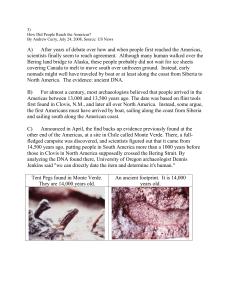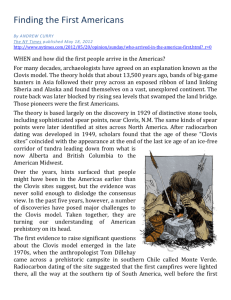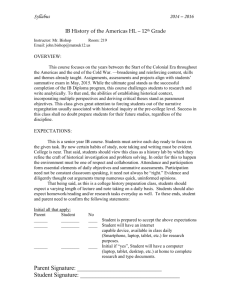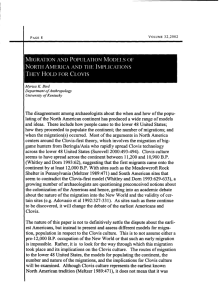Anthropology 2 Archaeology and World Prehistory
advertisement
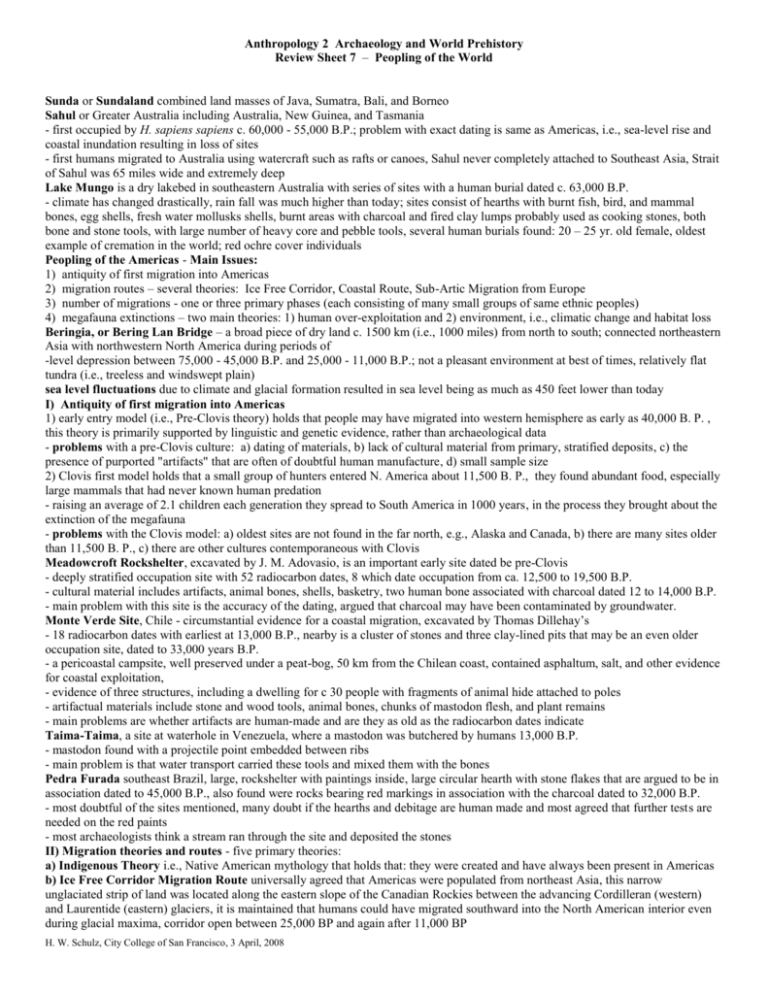
Anthropology 2 Archaeology and World Prehistory Review Sheet 7 – Peopling of the World Sunda or Sundaland combined land masses of Java, Sumatra, Bali, and Borneo Sahul or Greater Australia including Australia, New Guinea, and Tasmania - first occupied by H. sapiens sapiens c. 60,000 - 55,000 B.P.; problem with exact dating is same as Americas, i.e., sea-level rise and coastal inundation resulting in loss of sites - first humans migrated to Australia using watercraft such as rafts or canoes, Sahul never completely attached to Southeast Asia, Strait of Sahul was 65 miles wide and extremely deep Lake Mungo is a dry lakebed in southeastern Australia with series of sites with a human burial dated c. 63,000 B.P. - climate has changed drastically, rain fall was much higher than today; sites consist of hearths with burnt fish, bird, and mammal bones, egg shells, fresh water mollusks shells, burnt areas with charcoal and fired clay lumps probably used as cooking stones, both bone and stone tools, with large number of heavy core and pebble tools, several human burials found: 20 – 25 yr. old female, oldest example of cremation in the world; red ochre cover individuals Peopling of the Americas - Main Issues: 1) antiquity of first migration into Americas 2) migration routes – several theories: Ice Free Corridor, Coastal Route, Sub-Artic Migration from Europe 3) number of migrations - one or three primary phases (each consisting of many small groups of same ethnic peoples) 4) megafauna extinctions – two main theories: 1) human over-exploitation and 2) environment, i.e., climatic change and habitat loss Beringia, or Bering Lan Bridge – a broad piece of dry land c. 1500 km (i.e., 1000 miles) from north to south; connected northeastern Asia with northwestern North America during periods of -level depression between 75,000 - 45,000 B.P. and 25,000 - 11,000 B.P.; not a pleasant environment at best of times, relatively flat tundra (i.e., treeless and windswept plain) sea level fluctuations due to climate and glacial formation resulted in sea level being as much as 450 feet lower than today I) Antiquity of first migration into Americas 1) early entry model (i.e., Pre-Clovis theory) holds that people may have migrated into western hemisphere as early as 40,000 B. P. , this theory is primarily supported by linguistic and genetic evidence, rather than archaeological data - problems with a pre-Clovis culture: a) dating of materials, b) lack of cultural material from primary, stratified deposits, c) the presence of purported "artifacts" that are often of doubtful human manufacture, d) small sample size 2) Clovis first model holds that a small group of hunters entered N. America about 11,500 B. P., they found abundant food, especially large mammals that had never known human predation - raising an average of 2.1 children each generation they spread to South America in 1000 years, in the process they brought about the extinction of the megafauna - problems with the Clovis model: a) oldest sites are not found in the far north, e.g., Alaska and Canada, b) there are many sites older than 11,500 B. P., c) there are other cultures contemporaneous with Clovis Meadowcroft Rockshelter, excavated by J. M. Adovasio, is an important early site dated be pre-Clovis - deeply stratified occupation site with 52 radiocarbon dates, 8 which date occupation from ca. 12,500 to 19,500 B.P. - cultural material includes artifacts, animal bones, shells, basketry, two human bone associated with charcoal dated 12 to 14,000 B.P. - main problem with this site is the accuracy of the dating, argued that charcoal may have been contaminated by groundwater. Monte Verde Site, Chile - circumstantial evidence for a coastal migration, excavated by Thomas Dillehay’s - 18 radiocarbon dates with earliest at 13,000 B.P., nearby is a cluster of stones and three clay-lined pits that may be an even older occupation site, dated to 33,000 years B.P. - a pericoastal campsite, well preserved under a peat-bog, 50 km from the Chilean coast, contained asphaltum, salt, and other evidence for coastal exploitation, - evidence of three structures, including a dwelling for c 30 people with fragments of animal hide attached to poles - artifactual materials include stone and wood tools, animal bones, chunks of mastodon flesh, and plant remains - main problems are whether artifacts are human-made and are they as old as the radiocarbon dates indicate Taima-Taima, a site at waterhole in Venezuela, where a mastodon was butchered by humans 13,000 B.P. - mastodon found with a projectile point embedded between ribs - main problem is that water transport carried these tools and mixed them with the bones Pedra Furada southeast Brazil, large, rockshelter with paintings inside, large circular hearth with stone flakes that are argued to be in association dated to 45,000 B.P., also found were rocks bearing red markings in association with the charcoal dated to 32,000 B.P. - most doubtful of the sites mentioned, many doubt if the hearths and debitage are human made and most agreed that further tests are needed on the red paints - most archaeologists think a stream ran through the site and deposited the stones II) Migration theories and routes - five primary theories: a) Indigenous Theory i.e., Native American mythology that holds that: they were created and have always been present in Americas b) Ice Free Corridor Migration Route universally agreed that Americas were populated from northeast Asia, this narrow unglaciated strip of land was located along the eastern slope of the Canadian Rockies between the advancing Cordilleran (western) and Laurentide (eastern) glaciers, it is maintained that humans could have migrated southward into the North American interior even during glacial maxima, corridor open between 25,000 BP and again after 11,000 BP H. W. Schulz, City College of San Francisco, 3 April, 2008 c) Coastal Migration Route Knut Fladmark (1979, 1983) postulates an alternate marine-oriented migration scheme, he argued from paleoenvironmental evidence that an ice-free corridor, if it indeed existed, would have presented a harsh, frigid environment, often flooded, and devoid of biological resources needed for food, rather, he suggests that early Asians migrated along the coastlines of northeastern Asia, Beringia, and finally North America in a series of relatively short voyages, perhaps separated by fairly long periods of occupation of intervening coastal and island areas, he notes that a maritime people could have accomplished this using only small simple water craft, similar to those employed by Asian migrants to Australia, he believes that the people would have readily adapted to these environments, the logic of this argument is indisputable, but there is no archaeological evidence todocument such a coastal migration -- probably due to the dramatic rise in sea level following the melting of the glaciers d) Sub-artic Atlantic Route from Europe people migrated from Europe via the far north Atlantic c. 20,000 B. P. e) Trans Pacific Route (into South America) people migrated from the Pacific Islands, not considered a viable theory by vast majority of anthropologists III) Number of migrations four lines of evidence are used 1) linguistic; 2) dental; 3) archaeological; 4) genetic Linguistic evidence three general ethnic migrations - i.e., waves of people in groups, based on glottochronology a technique which attempts to provide dates for the earlier stages of languages much as radiocarbon 14 dating provides dates for archaeological finds,this method compares word list of related languages to determine the degree and rate of diachronic linguistic changes in an attempt to date the divergence of these languages from a parent language, conclusion: 1) three linguistic stocks represent separate migrations Dates: Amerind 11,000 -- Na-Dene = 9,000 -- Aleut-Eskimo = 4,000 1) Amerind - oldest, since centered further south and shows greatest diversity, absence of sharper differentiation in north suggests a rapid spread allowing no opportunity for development of one or more subgroups, however, if Central Amerind is proved to be a subgroup, there would have to be a period in the far north during which this divergence took place 2) Na-Dene has deeper internal divisions and less geographically peripheral than Aleut-Eskimos, in particular break between Haida and the remainder of Na-Dene requires a considerable time depth 3) Aleut-Eskimo is probably the most recent because its internal division is less deep than within Na-Dene, no debate about relationship bet Aleut and Eskimo like there is about Na-Dene and Haida Dental evidence - Sinodonts = northern Asians and all native Americans and Sundadonts = eastern Asians - Sinodonts are characterized by: 1) shoveled-shaped incisors, 2) single-rooted upper first premolar, 3) triple-rooted lower first molars - conclusion: using a battery of 28 key crown and root traits to determine dental variation w/in and between America and Eurasia, i.e. to deter the origins of Native Americans, using multivariate analysis = MMD (multivariate mean measures of divergence) four observations arise: 1) all Amerindian groups resemble each other more than they do most Old World populations 2) dental variation is greater in the north than in the south 3) Native Americans are more like Asians (Sundadonts) than Europeans 4) there are 3 dental cluster in New World which are similar to Amerind, Na-Dene, and Aleut-Eskimos General Dental Conclusion 1) this geographical-distance/dental-divergence relationship supports a rapid expanding-front colonization model like that proposed by Martin (1984) 2) based on similar amount of divergence bet S/E and N/E Asia, w/in Europe, and w/in Americas (S Am and Canada) it is clear that the peopling of the Americas was a relatively recent event 3) when a proposed worldwide rate of dental microevolution of 0.01 MMD/1,000 yrs. is applied to Macro-Indian samples, they have been separated from Northeast Asians on the average for 14,000 yrs. which coincides with Clovis Theory 4) Aleut-Eskimos entered as a distinct population already differentiated in Siberia, Aleut-Eskimos and Macro-Indians must have had a common ancestor in N. China 20,000 BP Archaeological evidence based primarily on Clovis points, i.e., fluted points – spear point with long channel flake removed from both sides of the base of the point to facilitate hafting, some argue that Clovis points are the earliest tool tradition, c. 11,500 to 11,000 B.P., found across United States, Folsom point later than Clovis, found primarily in the Great Plains area Genetic evidence - at least three major migrations and possibly four based on mtDNA as early as 45,000 B.P. (see below) - conclusions: 1) the oldest human skeletons directly dated by C-14 analysis based on an organic fraction are from the Wilsall site in Montana = 10,600 + 300 B. P. 2) isolation of mitochondrial DNA from the brain tissue of 8,000 yr. old skeletons from the Windover site in Florida 3) the interpretation of genetic data is secondary support for the primary inferences based on linguistic and dental data - other researchers have drawn very different conclusions based on portions of these same data - in fact, there is little agreement among those involved w/ the actual date collection and analysis regarding the number or identity of the major groupings of Native Americans based on genetic data 4) depending on the researcher there is either: a Pan-American Indian genetic group 5) from a genetic perspective the three separate migrations of three genetically separate groups of Native Americans is still without strong confirmation H. W. Schulz, City College of San Francisco, 3 April, 2008 IV) Extinction of megafauna - two primary theories: 1) overexploitation by humans and 2) environmental change Paul Martin Theory of Overkill, Martin (1982) proposed a model to account for the rather abrupt disappearance of the Pleistocene megafauna in North America, he attributed the extinction to "overkill" resulting from the activities of early human hunters, thus, human populations killed more animals than could be replaced at a normal rate of reproduction for undomesticated species, he calculated population growth at rates as high as 3.4% annually, doubling every 20 yr., w/ complete colonization of the Western Hemisphere in as little as 350 yr.; alternately, 1.4% annually, doubling every 50 yr., and colonizing WH in 800 yrs., he argues that people reached Tel Del Fuego in as little as 1000 yr. after crossing the Bering Straits, this represents an extreme view which is not entirely justifiable on theoretical grounds since the New World provided more ecological barriers to human movement and necessitated more restraint on the part of expanding human populations than he implies, this hypothesis also may not agree with available archaeological evidence that indicates the presence of humans were in North America longer than he implies Martin based his model on a number of analogies, including: 1) from New Zealand where twenty-seven species of Moa (flightless birds) were made extinct by humans in only a few centuries; 2) a 3.4% a year population growth rate among the mutineers from the British ship H.M.S. Bounty after they landed on Pitcairn Island, and 3) studies of animal invasions, e.g., a new species of giant snails in Africa and exotic animals introduced into New Zealand; this model has been criticized on a number of grounds: 1) the likelihood that human populations of the Pleistocene epoch could not have been sufficiently large to produce an impact of this magnitude on game resources and 2) kill sites have not been discovered in numbers that would support such a view; most archaeologists have attributed post-Pleistocene faunal extinction to paleoenvironmental changes which occurred as a result of the disappearance of the continental ice sheets or a combination of human activities and environmental factors - the earliest evidence for human hunting of Pleistocene fauna in North America comes from the Manis mastodon site near Sequim, Washington (Kirk and Daugherty 1978), at this site the remains of a mastodon butchered about 12,000 B.P. contained a bone projectile point embedded in a healed wound in one of the animal's ribs, this is regarded as unquestionable evidence of human in the northwestern U. S. as early as 12,000 BP. 2) Donald Grayson's "Climatic change theory"- extinctions are a reflection of the loss of 'climatic equability, and in particular to an increase in summer temperatures, he argues for a multivariate explanation, i.e. climate (lose of food supply) and human predation, this approach was popular before Martin's work in the 1960's), 35 genera went extinct, but only 8 survived past 12,000 B. P. H. W. Schulz, City College of San Francisco, 3 April, 2008
